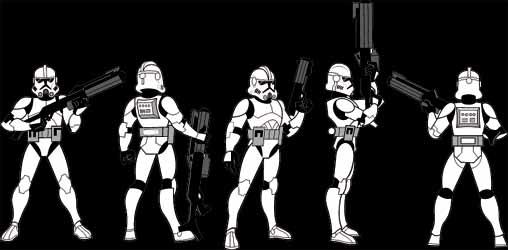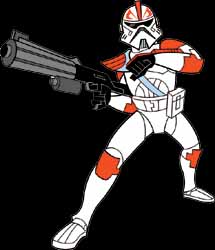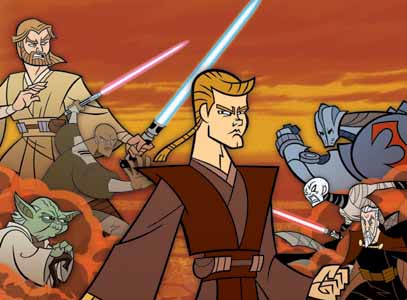|
Genndy Tartakovsky is the creator/writer/director of Dexter's
Laboratory and co-creator of Dial M For Monkey and
Justice Friends. In addition to being voted Toon of
the Year by Cartoon Network viewers in 1996, his first professional
cartoon creation Dexter's Laboratory has received four
Emmy nominations and an Annie Award. One of the youngest animation
directors in the industry, Tartakovsky was born and raised
in Moscow, U.S.S.R. until his family moved to Chicago when
he was seven years of age. After high school, Tartakovsky
studied film at Chicago's Columbia College before moving to
Los Angeles to study animation at Cal Arts. At Cal Arts he
wrote, directed, produced and animated two student films.
One of his films, which was selected for the Cal Arts Producers
Show, was the basis for Dexter's Laboratory. Sci-Fi-Online
spoke with him as his new series, Star Wars: Clone Wars,
was due to start broadcasting on Toonami...
ReviewGraveyard:
How was the Star Wars: Clone Wars project initiated?
Did Lucasfilm first contact Cartoon Network or vice-versa?
Genndy
Tartakovsky: . The project came together through joint conversations
between Lucasfilm and Cartoon Network. Lucas wants to keep
the Star Wars property robust and active between motion
picture releases. So they approached me and asked if I would
be interested in creating a one-minute program based on Star
Wars.
Well,
of course I said "yes," but told them that I couldn't really
do anything significant with one-minute episodes-it's simply
too short a time to tell a story. Cartoon Network went back
to Lucasfilm and told them that they would be working with
the team behind Samurai Jack [Emmy-winning series created
by Tartakovsk - pictured right]. And it turns out that George
Lucas watches and really admires Samurai Jack, so they
sent word that we now would be worthy of creating three-minute
Star Wars episodes.
When we got the greenlight from Lucasfilm, I still wasn't
really sure even three-minutes would work. So I took several
existing 22-minute episodes of Samurai Jack and re-edited
them into three-minute versions to see what I had. I wanted
to know that in three minutes you could make sense, capture
the viewer's interest and still tell a compelling story. And
I found that it actually worked, particularly if each instalment
worked to build upon the previous one, to offer an important
piece to the overall story arc, then end with a cliff-hanger
that would inspire the viewer to come back to see what happens
next. I think you'll see that each episode, despite being
only three minutes long, has a beginning, middle and an end
that pulls the viewer in and makes him or her want to know
more.
RG:
What is Lucasfilm's involvement with the creation of the series?
Has the company told you what storyline to follow or have
they given you a free hand?
GT:
They've been remarkably hands-off with us about Clone Wars.
I think once George Lucas gave his overall blessing or "seal
of approval" because of what we've achieved to date with
Samurai Jack, everyone felt they could trust us to handle
the property with the appropriate care and concern it deserves.
So we went away and developed our own storyline, a new perspective
and approach, along with character designs and production
elements-all of which really excited us-and we brought it
back and pitched the new scenario to them. And fortunately,
everyone really loved it.
Because
this project is composed of so many different short segments,
I like compare it to HBO's Band of Brothers - a project
I really admired that takes a huge story like the European
Allied campaign of World War II and presents it in a series
of "a day in the life of" stories. As I see it, this project
mirrors that approach by showcasing several "days in the life
of the Clone Wars." For instance, in the first few
episodes, we're presenting a singular, but extremely important
campaign, The Battle of Muunilinst, an all-city planet
under attack by the Imperial separatist movement. We're able
to explain the goals and obstacles the old Republic and Jedi
must face, reveal important internal conflicts between the
main characters, and still have time to highlight the action
of the battle.
RG:
Was there anything off-limits or forbidden to you from the
original story?
GT:
Really, there was only one area where we were told by Lucasfilm
not to approach, and that had to do with the love-story between
Anakin and Padmé. We actually had an idea originally where
at some point in the middle of the war, Anakin would have
a quiet moment and he would take out a small hologram picture
of Padmé and reflect upon how much he misses her. But since
we were told not to explore any romantic interest in the story,
we had to let that go. You will see Padmé, though, in the
very first episode as she waves goodbye and later on in the
series.

RG:
Were you a Star Wars fan as a kid?
GT.
Oh yes, of course. Really, everyone my age grew up with Star
Wars. It was definitely one of the first big movies I
saw after immigrating to America. I think it truly is one
of the most inspirational, most influential movies of our
generation. It certainly inspired me to dream of worlds beyond
the here and now.
RG:
Were you at all scared to take on such a cultural icon?
GT:
Oh, yeah, absolutely. At first I thought it really might be
more fun for someone else to do it, and then I could just
sit back and watch the show, because an animated Star Wars
is such a cool idea. But then I thought, "what if they make
it wrong?" Then I would be really upset, and I'd be left with
nothing to do but complain: "Well, we should have made
it!" So, because I'm a rather aggressive person, I reasoned
that I'd better take the challenge myself.
 |
What
I should add, though, is that once we accepted the project,
literally everyone who was to work on it found themselves
extremely hesitant to take the first steps. Paul Rudish, the
art director for the show, with whom I've worked for years
on Dexter's Laboratory and Samurai Jack, is
the type of guy who can draw anything, anytime and anywhere
without hesitation-he's amazing. But on the first week of
Star Wars: Clone Wars... complete brain freeze at the
drawing board! Absolutely nothing would come forth. He couldn't
draw, couldn't come up with a palate, anything. And he knows
Star Wars better than anyone on the team - could normally
draw R2-D2 freehand in total perspective with all the mechanical
gadgets... now nothing!
We
finally had to take our minds off the enormity of it all and
just approach this thing like any other project. At last,
once we relaxed, it all began to flow naturally.
RG:
What animation processes are you using with this project?
Is there CGI (computer generated imaging) involved, or 3D?
GT:
Most of the visual elements in Star Wars: Clone Wars
have been created through traditional cell animation at this
point. However,
we have added CGI elements to the production, including computer-generated
spaceships that help create the action and excitement of the
dogfights in space that are so much a part of the Star
Wars appeal.
RG:
Can you tell us more about the sound and soundtrack to the
production?
GT:
One of the signature elements to Star Wars is the unique
sound Lucasfilm created for the motion picture series. We
were extremely fortunate to have Skywalker Sound create the
sound effects and background elements for Star Wars: Clone
Wars as well.
I
was amazed that when the tapes came back to us from Skywalker
the whole show suddenly seemed "legitimate." I mean it had
the same recognisable sounds as any one of the feature films.
We simply couldn't have reproduced this sound on our own.
Every
single sound effect in Clone Wars comes directly from
the library comprised of the first five movies. And the best
part is that we have several new individual sounds in our
production that came from mixing two or more different sounds
used in the films.
And
as for the music, we've been able to use the classic, Oscar-winning
John Williams compositions that Star Wars fans expect
to hear. Again, this familiar music just makes Star Wars:
Clone Wars completely "legitimate."
RG:
How did you go about creating the animated versions of the
characters within Clone Wars? Did you try to stay faithful
to the face and bodies of the live-action characters in the
films?
GT:
This actually presented our first stumbling block. Originally,
Paul Rudish kept drawing the actors (or caricatures of them)
who portrayed the roles in the motion pictures. But this didn't
come out right-they didn't look like the essence of the character
they were supposed to be. So we started experimenting and
determined that our own versions of the characters, ones that
merely resembled the actors who played them onscreen, and
it worked better in the long-run. They still have qualities
that reflect the actors who originally portrayed them, but
there are also elements which are drawn from our thoughts
about the character.
RG:
The voices of the animated characters sound very much like
the actors who portrayed them in the movies. Are they the
same?
GT:
That actually was a big concern of mine, that the voices sound
authentic. No, the actors in the animated series are amazingly
talented voice-artists who were able to create readings that
are incredibly close to their live-action counterparts. And
they were such good actors, too, which made the recordings
a wonderful experience overall. Only Anthony Daniels, the
original C-3PO, supplies the voice for both the live-action
and animated versions of his character.
RG:
What did you think of the fan and public reaction to the first
10 episodes of Star Wars: Clone Wars?
GT:
I've been pretty pleased with most of the things I have heard.
The responses I have heard from kids have been the best. They
really liked it. I heard about one couple that recorded all
the episodes and they use it as a bribery tool - if their
kid is good, they'll let him watch an episode.
It's also been pretty positive from the hard-core fans. I
think the biggest complaint has been the time. Everyone wanted
them to be longer. But overall everyone has been happy with
all the action and the way that we portrayed the characters.
At least that's what I've learned from talking to people and
on the Internet.
Of course, there are always going to be people who don't like
something. But it seems like about 90 percent of the people
really liked it.
RG: How has this experience changed
the way you approach your craft - in terms of storytelling,
how to build action sequences and how long a cartoon needs
to be?
GT:
I think that working in a limited time frame taught me how
to really boil down storytelling to the most essential bits.
Where we could stretch out in Samurai Jack, here we
had to distil everything - to make it much, much shorter and
have the same emotional impact.
The
ability to finesse dialogue was a big issue as well. We really
had to be much more precise with the words to fit into the
time frame. We had to condense it into its perfect form -
to say nothing more than needs to be said, but also nothing
less.
It
was also useful to work on someone else's characters. It was
kind of difficult. For most of my career, I have worked on
my own stuff or things I have helped create. This was hard
- to do justice to someone else's creation.
RG:
What's next for you now?
GT:
I want to work on an animated feature, but I'll need a little
time off to think after this.
RG:
Thank you for your time.

With
thanks to David Cox at Wired
The
new Star Wars: Clone Wars animated mini-series will
start broadcasting in 12-minute episodes on Toonami from the
21 March 2005.
Return
to...

|